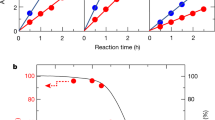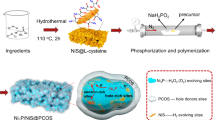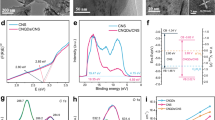Abstract
The photocatalytic splitting of water into hydrogen and oxygen using solar energy is a potentially clean and renewable source for hydrogen fuel. The first photocatalysts suitable for water splitting1, or for activating hydrogen production from carbohydrate compounds made by plants from water and carbon dioxide2, were developed several decades ago. But these catalysts operate with ultraviolet light, which accounts for only 4% of the incoming solar energy and thus renders the overall process impractical. For this reason, considerable efforts have been invested in developing photocatalysts capable of using the less energetic but more abundant visible light3,4,5,6,7, which accounts for about 43% of the incoming solar energy. However, systems that are sufficiently stable and efficient for practical use have not yet been realized. Here we show that doping of indium-tantalum-oxide with nickel yields a series of photocatalysts, In1-xNixTaO4 (x = 0–0.2), which induces direct splitting of water into stoichiometric amounts of oxygen and hydrogen under visible light irradiation with a quantum yield of about 0.66%. Our findings suggest that the use of solar energy for photocatalytic water splitting might provide a viable source for ‘clean’ hydrogen fuel, once the catalytic efficiency of the semiconductor system has been improved by increasing its surface area and suitable modifications of the surface sites.
This is a preview of subscription content, access via your institution
Access options
Subscribe to this journal
Receive 51 print issues and online access
$199.00 per year
only $3.90 per issue
Buy this article
- Purchase on Springer Link
- Instant access to full article PDF
Prices may be subject to local taxes which are calculated during checkout




Similar content being viewed by others
References
Honda, K. & Fujishima, A. Electrochemical photolysis of water at a semiconductor electrode. Nature 238, 37–38 (1972).
Kawai, T. & Sakata, T. Conversion of carbohydrate into hydrogen fuel by a photocatalytic process. Nature 286, 474–476 (1980).
Linsebigler, A. L., Lu, G. & Yates, J. T. Jr Photocatalysis on TiO2 surfaces: principles, mechanisms, and selected results. Chem. Rev. 95, 735–758 (1995).
Geoffrey, B. S. & Thomas, E. M. Visible light photolysis hydrogen using sensitized layered metal oxide semiconductors: the role of surface chemical modification in controlling back electron transfer reactions. J. Phys. Chem. B 101, 2508–2513 (1997).
Kim, Y. II., Salim, S., Huq, M. J. & Mallouk, T. E. Visible light photolysis of hydrogen iodide using sensitized layered semiconductor particles. J. Am. Chem. Soc. 113, 9561–9563 (1991).
Yoshimure, J., Ebina, Y., Kondo, J. & Domen, K. Visible light induced photocatalytic behavior of a layered perovskite type niobate, RbPb2Nb3O10. J. Phys. Chem. 97, 1970–1973 (1993).
Kudo, A. & Mikami, I. New In2O3(ZnO)m photocatalysts with laminal structure for visible light induced H2 or O2 evolution from aqueous solutions containing sacrificial reagents. Chem. Lett. 1027–1028 (1998).
Zou, Z., Ye, J. & Arakawa, H. Structural properties of InNbO4 and InTaO4: correlation with photocatalytic and photophysical properties. Chem. Phys. Lett. 332, 271–277 (2000).
Zou, Z., Ye, J. & Arakawa, H. Substitution effects of In3+ by Al3+ and Ga3+ on the photocatalytic and structural properties of the Bi2InNbO7 photocatalyst. Chem. Mater. 13, 1765–1769 (2001).
Kim, H. G., Hwang, D. W., Kim, J., Kim, Y. G. & Lee, J. Highly donor-doped (110) layered perovskite materials as novel photocatalysts for overall water splitting. Chem. Commun. 1077–1078 (1999).
Kudo, K. et al. Nickel-loaded K4Nb6O17 photocatalyst in the decomposition of H2O into H2 and O2: Structure and reaction mechanism. J. Catal. 120, 337–352 (1989).
Izumi, F. J. A software package for the Rietveld analysis of X-ray and neutron diffraction patterns. Crystallogr. Ass. Jpn 27, 23–31 (1985).
Machida, M., Yabunaka, J.-i. & Kijima, T. Synthesis and photocatalytic property of layered perovskite tantalates, RbLnTa2O7 (Ln = La, Pr, Nd, and Sm). Chem. Mater. 12, 812–817 (2000).
Kim, Y. II., Atherton, S., Brigham, E. S. & Mallouk, T. E. Sensitized layered metal oxide semiconductor particles for photochemical hydrogen evolution from nonsacrificial electron donors. J. Phys. Chem. 97, 11802–11810 (1993).
Dare-Edwards, M. P., Goodenough, J. B., Hammett, A. & Nicholson, N. D. Photoelectrochemistry of nickel (II) oxide. J. Chem. Soc. Faraday Trans. 77, 643–661 (1981).
Acknowledgements
This work was supported in part by the COE project, Japan Ministry of Education and Science.
Author information
Authors and Affiliations
Corresponding author
Rights and permissions
About this article
Cite this article
Zou, Z., Ye, J., Sayama, K. et al. Direct splitting of water under visible light irradiation with an oxide semiconductor photocatalyst. Nature 414, 625–627 (2001). https://doi.org/10.1038/414625a
Received:
Accepted:
Issue Date:
DOI: https://doi.org/10.1038/414625a
This article is cited by
-
Surface plasmon resonance enhanced photocatalytic activity of novel Au@CuAl2O4 fibers under visible light
Journal of Materials Science: Materials in Electronics (2024)
-
Approaching the commercial threshold of solar water splitting toward hydrogen by III-nitrides nanowires
Frontiers in Energy (2024)
-
Solar-to-hydrogen efficiency of more than 9% in photocatalytic water splitting
Nature (2023)
-
Elastic, optoelectronic and photocatalytic properties of semiconducting CsNbO3: first principles insights
Scientific Reports (2023)
-
Cerium doped zinc oxide nanoparticles loaded non-woven polypropylene fabric for photo decolourization of Congo red under visible light irradiation
Journal of Materials Science: Materials in Electronics (2023)
Comments
By submitting a comment you agree to abide by our Terms and Community Guidelines. If you find something abusive or that does not comply with our terms or guidelines please flag it as inappropriate.



